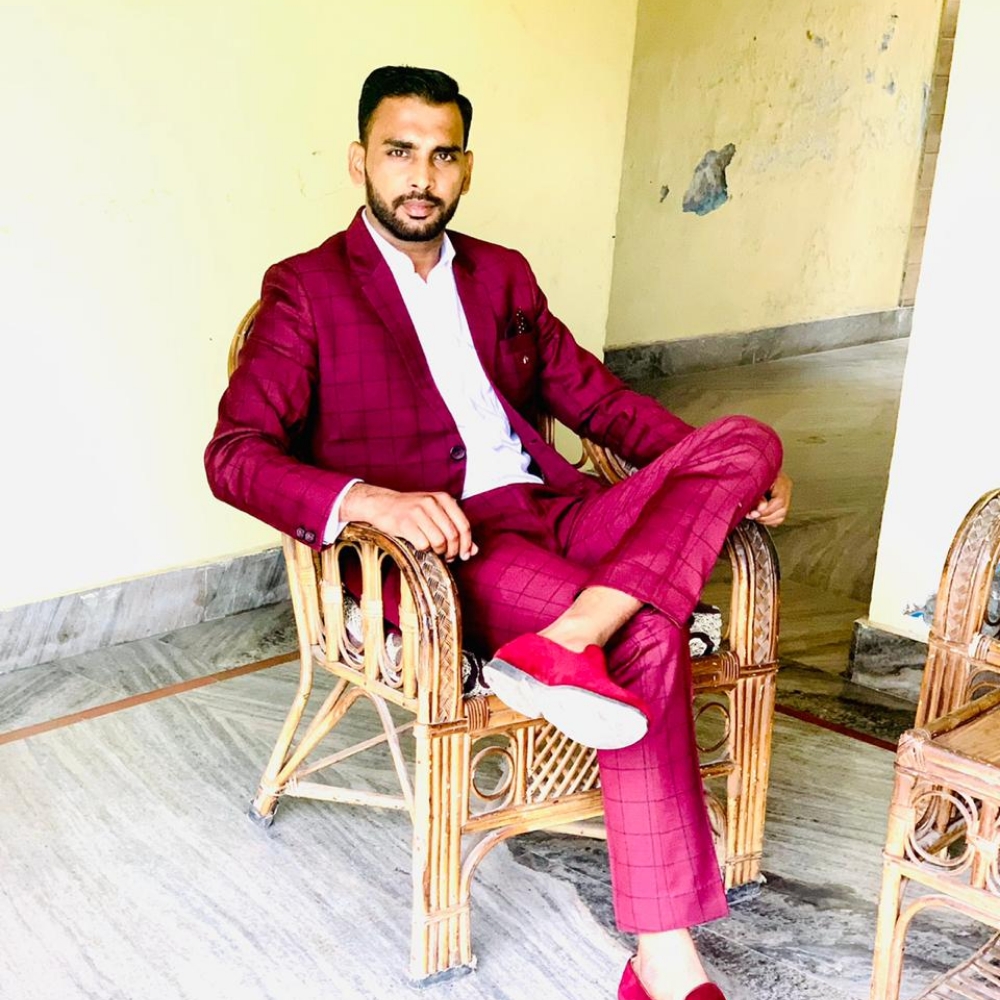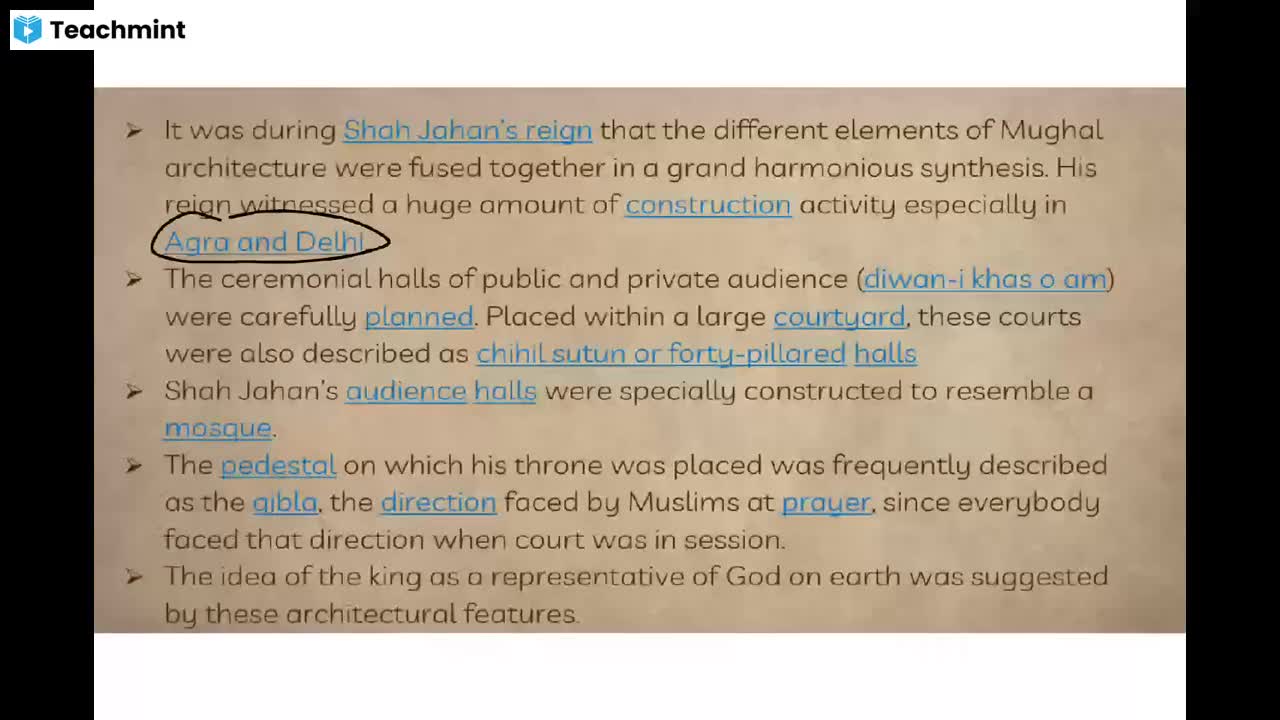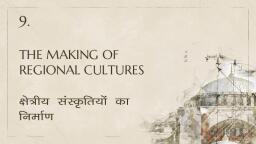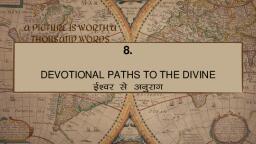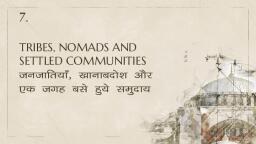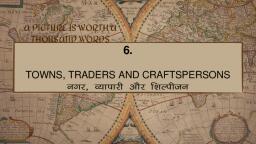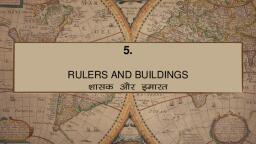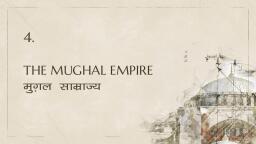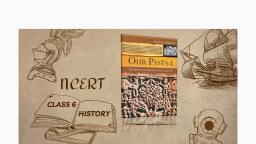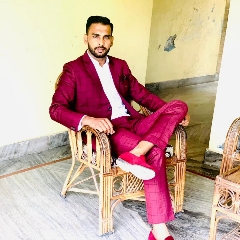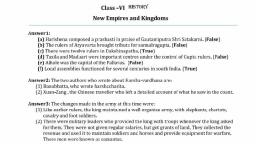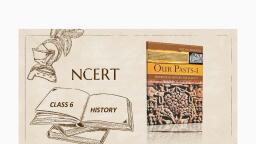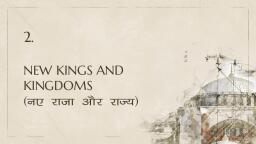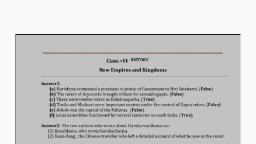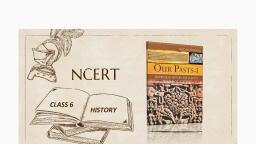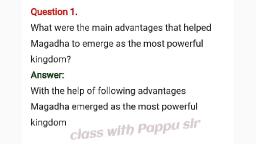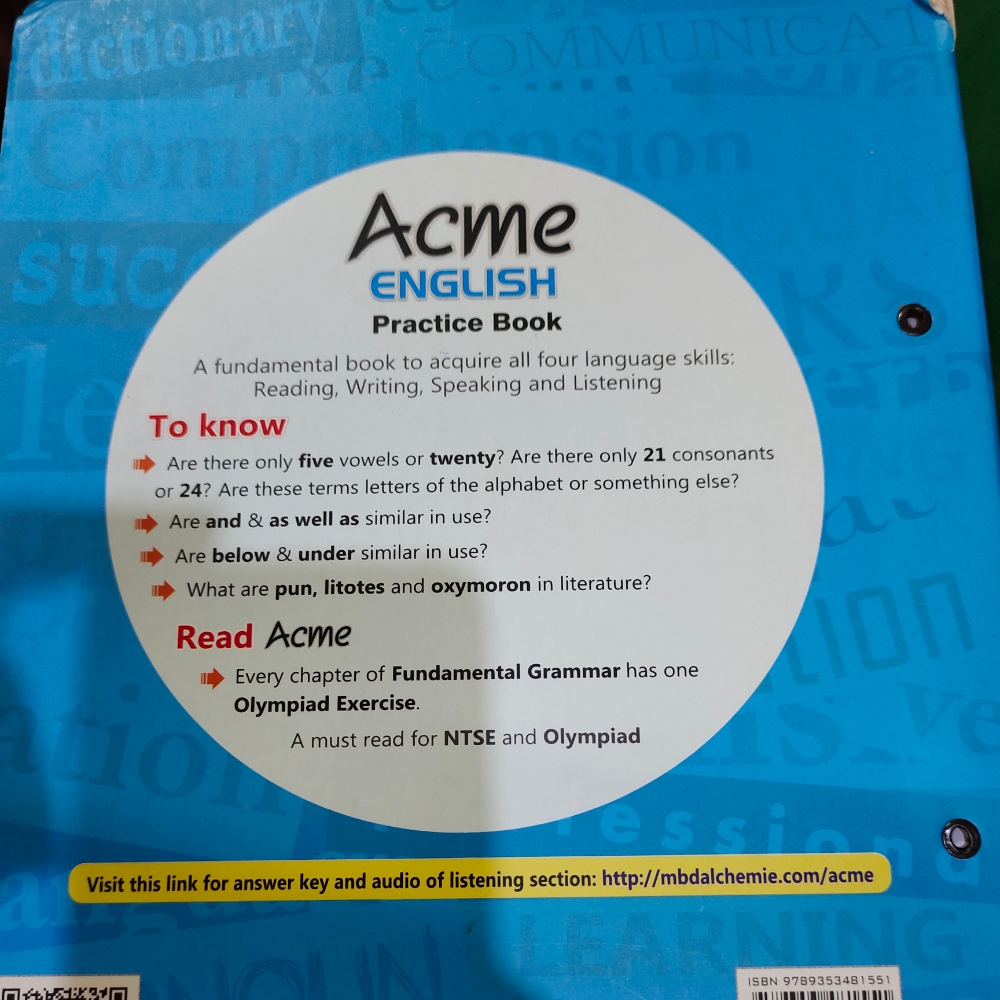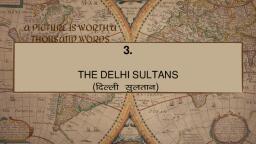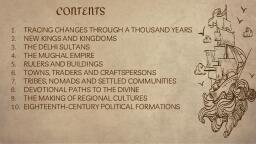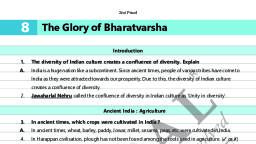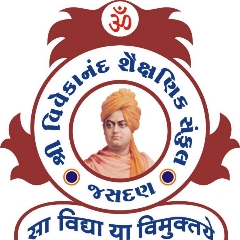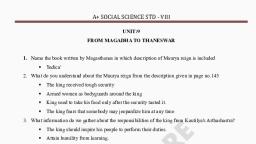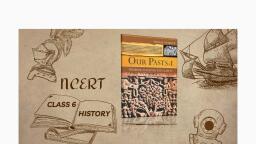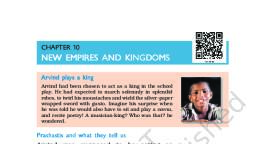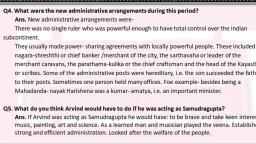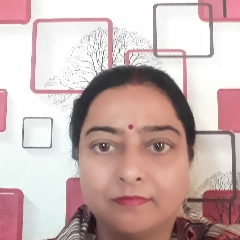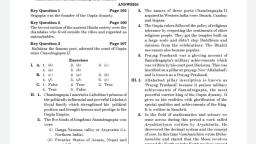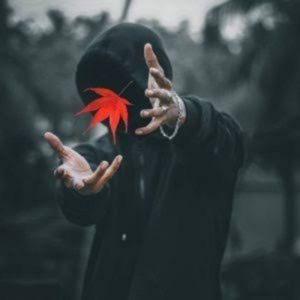Page 2 :
A PICTURE IS WORTH A, THOUSAND WORDS, , 10., NEW EMPIRES AND KINGDOMS, u, lkezkT; vkSj jkT;
Page 3 :
OVERVIEW ?, 1., 2., 3., 4., 5., 6., 7., 8., 9., , PRASHASTIS AND WHAT THEY TELL US, SAMUDRAGUPTA’S PRASHASTI, GENEALOGIES (lists of ancestors), HARSHAVARDHANA AND THE HARSHACHARITA, THE PALLAVAS, CHALUKYAS, PULAKESHIN’S PRASHASTI, HOW WERE THESE KINGDOMS ADMINISTERED?, A NEW KIND OF ARMY, ASSEMBLIES IN THE SOUTHERN KINGDOMS, ORDINARY PEOPLE IN THE KINGDOMS
Page 4 :
PRASHASTIS AND WHAT THEY TELL US, ● Samudragupta from a long inscription, inscribed on the Ashokan, , pillar at Allahabad., ● It was composed as a Kavya by Harishena, who was a poet and a, , minister at the court of Samudragupta., ● This inscription is of a special kind known as a prashasti, a Sanskrit, , word, meaning ‘in praise of’ ( _iz'kalk). While prashastis were, composed for some of the rulers you read about in Chapter 9, such, as Gautamiputra Shri Satakarni, they became far more important, from the time of the Guptas.
Page 5 :
SAMUDRAGUPTA’S PRASHASTI, ● The poet praised the king in glowing terms — as a warrior, as a king, , who won victories in battle, who was learned and the best of poets., He is also described as equal to the gods. The prashasti was, composed in very long sentences., ● Here is part of one such sentence:, Samudragupta the warrior whose body was most charming, being, covered with the plenteous beauty of the marks of hundreds of scars, caused by battle-axes, arrows, spikes, spears, barbed darts, swords,, iron clubs, javelins, barbed arrows, long arrows and many other, weapons.
Page 7 :
Map on next slide is based on the information provided in the prashasti., Harishena describes four different kinds of rulers, and tells us about, , Samudragupta’s policies (uhfr) towards them., 1., , The rulers of Aryavarta, the area shaded in green on the map. Here, there were nine rulers who were uprooted, and their kingdoms were, made a part of Samudragupta’s empire., , 2., , The rulers of Dakshinapatha. Here there were twelve rulers, some of, whose capitals are marked with red dots on the map. They surrendered, to Samudragupta after being defeated and he then allowed them to, rule again.
Page 8 :
3. The inner circle of neighbouring states, including Assam, coastal Bengal,, Nepal, and a number of gana sanghas (remember Chapter 5) in the, northwest, marked in purple on the map. They brought tribute, followed, his orders, and attended his court., 4. The rulers of the outlying areas, marked in blue on the map, perhaps the, descendants of the Kushanas and Shakas, and the ruler of Sri Lanka, who, submitted to him and offered daughters in marriage.
Page 10 :
The king who played the veena., Some other qualities of, Samudragupta are shown on, coins such as this one, where he is, shown playing the veena.
Page 11 :
VIKRAM SAMVAT, The era beginning in the 58 BCE is traditionally associated with, Gupta king, Chandragupta II, who had founded it as a mark of, victory over the Shakas and assumed the title of Vikramaditya., Vikrama Samvat, an Indian calendar era beginning in 57 BCE, is, associated with the legendary Vikramaditya.
Page 12 :
GENEALOGIES (oa'kkofy;k¡), Most prashastis also mention the ancestors of the ruler., This one mentions Samudragupta’s great grandfather,, , grandfather, father and mother., His mother, Kumara devi, belonged to the Lichchhavi gana, while, His father, Chandragupta, was the first ruler of the Gupta dynasty to, adopt the grand title of maharaj-adhiraja, a title that Samudragupta, also used., His great grandfather and grandfather are mentioned simply as maharajas. It seems as if the family gradually rose to importance
Page 13 :
Samudragupta inturn figures in, , the genealogies (lists of, ancestors) of later rulers of the, dynasty,, Such as his son, Chandragupta II., We know about him from, inscriptions and coins. He led an, expedition to western India,, where he overcame the last of, the Shakas., (According to later belief, his, court was full of learned people.)
Page 14 :
HARSHAVARDHANA AND THE HARSHACHARITA, Harshavardhana, who ruled nearly 1400 years ago, (Known from, , biographies)., His court poet, Banabhatta, wrote his biography, the Harshacharita,, in Sanskrit. This gives us the genealogy of Harsha, and ends with his, becoming king., Xuan Zang, about whom you read in Chapter 9, also spent a lot of, time at Harsha’s court and left a detailed account of what he saw
Page 15 :
Harsha was not the eldest son of his father, but became king of, Thanesar after both his father and elder brother died., His brother-in-law was the ruler of Kanauj and he was killed by the, ruler of Bengal., Harsha took over the kingdom of Kanauj, and then led an army, against the ruler of Bengal., , , Although he was successful in the east, and conquered Magadha, and probably Bengal also, he was not as successful elsewhere., He tried to cross the Narmada to march into the Deccan, but was, stopped by a ruler belonging to the Chalukya dynasty, Pulakeshin II.,
Page 18 :
Aihole, the capital of the Chalukyas, was an important trading centre ., It developed as a religious centre, with a number of temples. The, , Pallavas and Chalukyas frequently raided one another’s lands,, especially attacking the capital cities, which were prosperous towns., The best-known Chalukya ruler was Pulakeshin II., We know about him from a prashasti, composed by his court poet, , Ravikirti. This tells us about his ancestors, who are traced back through, four generations from father to son. Pulakeshin evidently got the, kingdom from his uncle.
Page 19 :
Pulakeshin’s prashasti, According to Ravikirti, he led expeditions along both the west and the, , east coasts., Besides, he checked the advance of Harsha. There is an interesting play, of words in the poem. Harsha means happiness. The poet says that, after this defeat, Harsha was no longer Harsha!, Pulakeshin also attacked the Pallava king, who took shelter behind the, walls of Kanchipuram. But the Chalukya victory was short-lived., Ultimately, both the Pallavas and the Chalukyas gave way to new, , rulers belonging to the Rashtrakuta and Chola dynasties, .
Page 20 :
HOW WERE THESE KINGDOMS ADMINISTERED?, As in the case of earlier kings, land revenue remained important for, , these rulers, and the village remained the basic unit of, administration., There were some new developments as well. Kings adopted a, number of steps to win the support of men who were powerful,, either economically, or socially, or because of their political and, military strength. For instance:, • Some important administrative posts were now hereditary. This, means that sons succeeded fathers to these posts., For example, the poet Harishena was a maha-danda-nayaka, or, chief judicial officer, like his father.
Page 21 :
Sometimes, one person held many offices., For instance, besides being a maha-danda-nayaka, Harishena was a, kumar-amatya, meaning an important minister, and a sandhivigrahika, meaning a minister of war and peace., • Besides, important men probably had a say in local administration., These included the nagarashreshthi or chief banker or merchant of the, city, the sarthavaha or leader of the merchant caravansthe prathamakulika or the chief craftsman, and the head of the kayasthas or scribes., , , , These policies were reasonably effective, but sooner or later, some of, these powerful men grew strong enough to set up independent, kingdoms.
Page 22 :
A NEW KIND OF ARMY, Like earlier rulers, some of these kings maintained a well-organised, , army, with elephants, chariots, cavalry and foot soldiers., Besides, there were military leaders who provided the king with, troops whenever he needed them., They were not paid regular salaries. Instead, some of them received, grants of land. They collected revenue from the land and used this, to maintain soldiers and horses, and provide equipment for warfare., These men were known as samantas. Whenever the ruler was weak,, samantas tried to become independent.
Page 23 :
ASSEMBLIES (lHkk,¡) IN THE SOUTHERN, KINGDOMS, The inscriptions of the Pallavas mention a number of local assemblies., , These included the sabha, which was an assembly of brahmin land, owners. This assembly functioned through subcommittees, which looked, after irrigation, agricultural operations, making roads, local temples, etc., The ur was a village assembly found in areas where the land owners, were not brahmins. And, The nagaram was an organisation of merchants. It is likely that these, assemblies were controlled by rich and powerful landowners and, merchants. Many of these local assemblies continued to function for, centuries..
Page 24 :
ORDINARY PEOPLE IN THE KINGDOMS, Kalidasa is known for his plays depicting life in the king’s court., An interesting feature about these plays is that the king and most, , brahmins are shown as speaking Sanskrit, while women and men, other than the king and brahmins use Prakrit., His most famous play, Abhijnana Shakuntalam, is the story of the, love between a king named Dushyanta and a young woman named, Shakuntala., We find an interesting description of the plight of a poor fisherman, in this play.
Page 25 :
A FISHERMAN FINDS A RING, ,d eNqvkjs dks ,d vaxwBh feyh, A fisherman found a precious ring,, which the king had given to Shakuntala, but which had been, accidentally swallowed by a fish., When he went to the palace with it, the gatemen accused him of, theft, and the chief police officer was rather rude., However, the king was happy when he saw the ring and sent a, reward for the fisherman., Then, the police officer and the gatemen decided to take a share, of the reward, and went along with the fisherman to have a drink
Page 26 :
The Chinese pilgrim Fa Xian noticed the plight of those who were, , treated as untouchables by the high and mighty., They were expected to live on the outskirts of the city., He writes:, “If such a man enters a town or a market place, he strikes a, piece of wood, in order to keep himself separate; people,, hearing this sound, know what it means and avoid touching, him or brushing against him.”
Page 27 :
Banabhatta provides us with a vivid picture of the king’s army on the, , , , , , , , move:, The king travelled with an enormous amount of equipment., Apart from weapons, there were things of daily use such as pots, pans,, furniture, golden footstools, food, including animals such as goat, deer,, rabbits, vegetables, spices, carried on carts or loaded on to pack animals, such as camels and elephants., This huge army was accompanied by musicians beating drums, and, others playing horns and trumpets., Villagers had to provide hospitality along the way. They came with gifts, of curds, gur and flowers, and provided fodder for the animals., They also tried to meet the king, and place their complaints and petitions, before him.
Page 28 :
The army left a trail of destruction behind. Elephants often trampled, , down the huts of villagers, and the oxen yoked to the caravans of, merchants ran away, scared by the tumult., As Banabhatta says: “The whole world was swallowed up in dust.”
Page 29 :
ARABIA, Although it is a desert, it was at the hub of communications for, , centuries. In fact, Arab merchants and sailors played an important role, in the sea trade between India and Europe, Others who lived in Arabia were the Bedouins, pastoral tribes, depending mainly on camels, hardy animals that could survive in the, desert., Around 1400 years ago, Prophet Muhammad introduced a new, religion, Islam, in Arabia., Like Christianity, Islam was a religion that laid stress on the equality and, unity of all before Allah, the one supreme god.
Page 30 :
Here is a verse from the Quran, the sacred book of Islam:, , “For Muslim men and women, for believing men and women, for devout, men and women, for true men and women, for men and women who, are patient and constant, for men and women who humble themselves,, for men and women who give in charity, for men and women who fast,, for men and women who guard their chastity, and for men and women, who engage much in Allah’s remembrance, for them has Allah, prepared forgiveness and great reward.”
Page 31 :
Within a hundred years Islam spread to north Africa, Spain, Iran and, , India. Arab sailors, who were already familiar with the coastal, settlements of the subcontinent, now brought the new religion with, them. Arabs soldiers, conquered Sind, (in present-day Pakistan), about 1300 years ago.
Page 32 :
TAKEAWAYS, TRUE OR FALSE :(a) Harishena composed a prashasti in praise of, (b), (c), (d), (e), (f), , Gautamiputra Shri Satakarni., The rulers of Aryavarta brought tribute for, Samudragupta., There were twelve rulers in Dakshinapatha., Taxila and Madurai were important centres under, the control of the Gupta rulers., Aihole was the capital of the Pallavas., Local assemblies functioned for several centuries in, south India
Page 33 :
THANKS !
